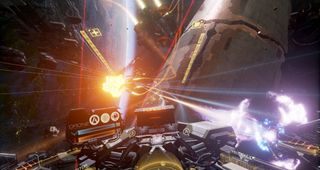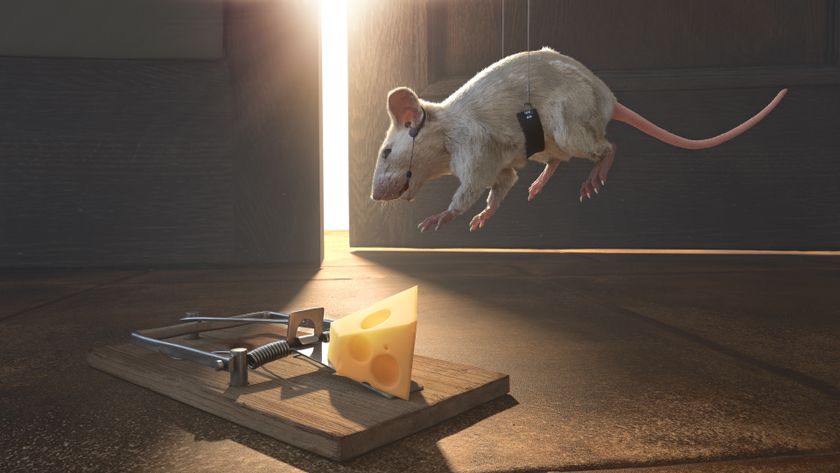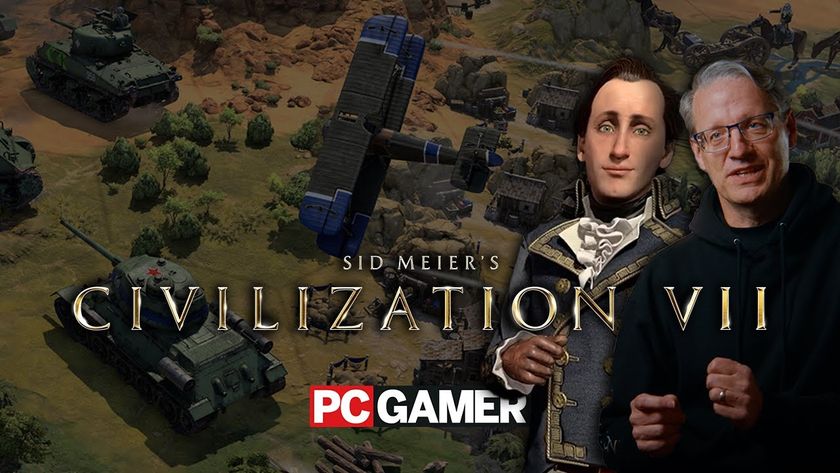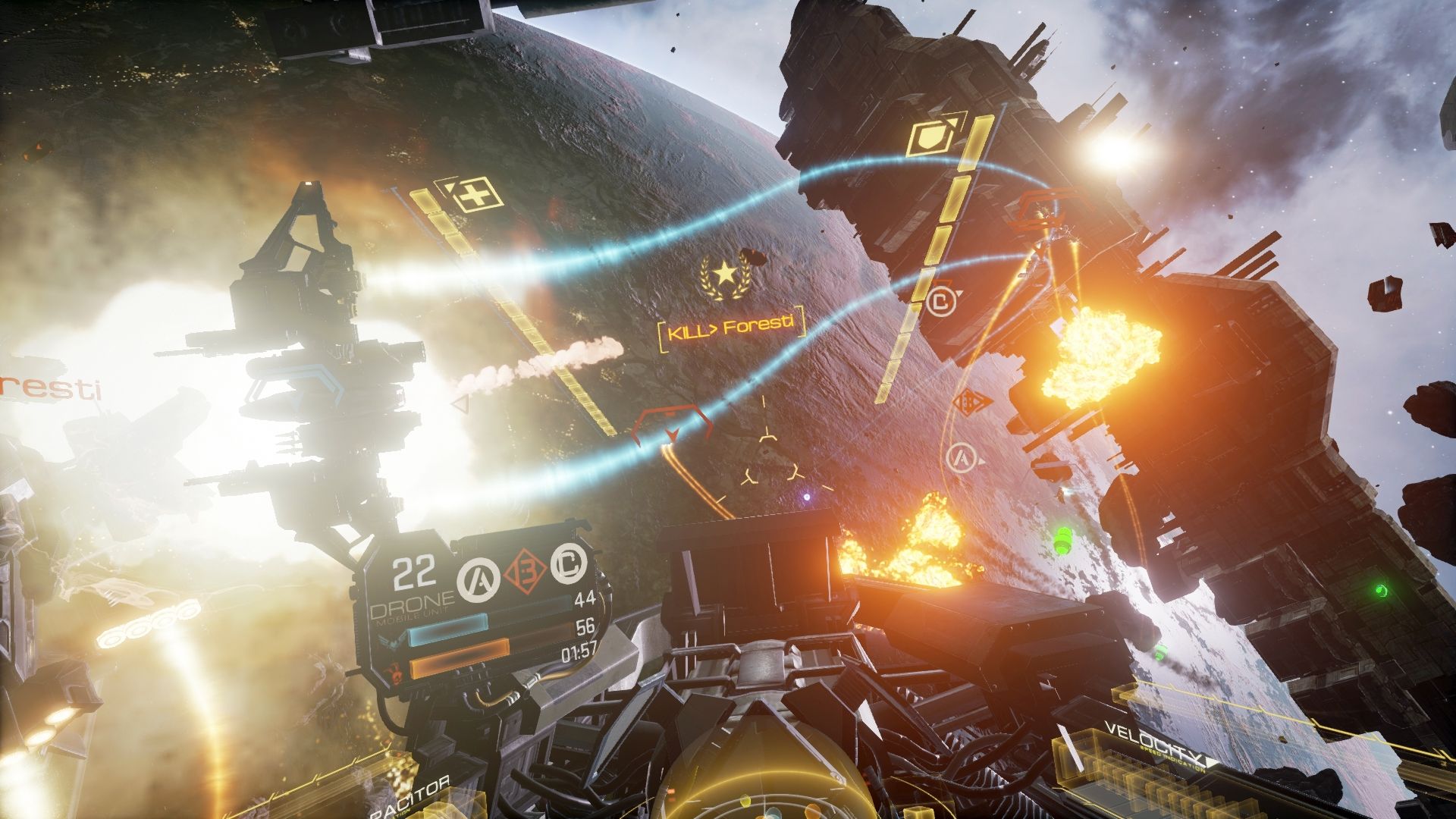Our Verdict
Strong first impressions make this ideal when showing off your new Rift headset, but theres little to keep you flying beyond those first few moments.
PC Gamer's got your back
The idea is so simple that an eight year old could conjure it up. In fact it’s probably one that most eight-year-olds since 1977 have at one point or another fantasised about. Pop an Oculus Rift on your head, boot up Eve: Valkyrie and suddenly you’re inside the cockpit of a careening, laser-loaded, missile firing, dip-dodge and diving, space-bound dog-fighter.
What is it Oculus Rift launch game set in the Eve universe, letting you take control of a dog-fighting space ship.
Publisher CCP Games
Developer CCP Games
Reviewed on I7-5820k, 16GB RAM, NVIDIA GeForce GTX 970
Expect To Pay Free with Oculus Rift
Multiplayer 1-8 players
Link Official site
It’s proper gasp-out-loud stuff, seeing enemy ships zoom past and being able to follow them with real life head turns as they go. The most immediately arresting, and perhaps surprising thing about all this, especially considering its foundation in the famously complex Eve Online universe, is just how intuitive it all is. Holding a gamepad in your hand and using the sticks to control the pitch and yaw of your vessel is a breeze, while your weapon systems are tied to the two triggers. Lasers fire straight forward, requiring active tailing of foes and proper positional awareness in order to fire just ahead of them in time-honoured flight-fighting fashion. Missiles meanwhile are where all that VR innovation suddenly becomes a much more active ingredient.
Pressing left trigger then eyeballing foes and following their trajectory up, down, and all around allows time for your missiles to achieve lock-on. The longer you’re able to keep a bad ‘un in view, the more of your missiles you can unload on them at once. Get yourself in a prime position, free of nearby debris and with an open view of your quarry. Hear the beeping indicator alerting you of a lock-on, and then release your left trigger to let loose the payload. It’s intensely satisfying stuff, and the sort of videogame joy that’s immediate and clear. The thrill of having the Kill indicator popping up in front of your face as you wheel away from a hard-earned barrage of death ‘splosions to your rear is something everyone can appreciate. I even tested it on some non-gaming relatives—it’s easier to show people what the Rift is than to explain why there is now a mountain of cables and hardware taking over your living room—and it had them gasping, cooing and ahhing. I couldn’t get my Dad into bowling on the Wii yet here he was happily downing spaceships in an Eve game. In VR. Who knew?
Valkyrie, by its nature, is an arcade experience. Those of us weaned on the likes of Elite: Dangerous or prior to that, Freespace, will find their cockpit stripped back and built for shorter, shallower, yet more bombastic combat experiences. Having sunk hundreds of hours into both of those aforementioned games, I invariably found myself looking around my Valkyrie cockpit and wishing I could interact with the myriad levers, buttons and flashing doo-dads that fill the space. I couldn’t.

And yet for all the essentially useless tat on display there’s a respectable efficiency to certain individual elements of the cockpit’s design. Shield and hull armour meters hang in front of you to either side, and as you go about the task of not blowing up you find yourself actively looking around whenever a red emergency light’s glow extends into your missile firing vision. Which, again, feels cool, giving your gaze yet more agency.
When it comes to the world outside of your cockpit there are further appreciable design tweaks to enable or reinforce your probably soon-to-be aching neck’s influence on proceedings. Enemy ships leave a very clear red tail behind them, much more so than would normally be found in your typical dog-fighter, just to make it that little bit easier to crane your view in their direction. Hull integrity can be boosted by picking up floating armour packs—I did say it was an arcade experience—which glow tell tale green against the backdrop of explosions and general space chaos ensuing around them.
The Oculus Rift store rates Valkyrie’s comfort level as ‘Intense’ for a very good reason.
But for all the depth in design Valkyrie remains a fairly shallow experience. There’s a levelling up and ship upgrade system, which through play allows you to tinker with your load outs. It’s a lamentably slow process. It might take hours to even gain access to your first upgrade, and this is only an incremental stat boost which I could hardly even notice the effects of once equipped. It takes even longer to earn yourself a new ship, and unfortunately, by that point you’ll have repeated the same stages, and the same actions, tens of times over and it’s easy to feel like you’ve seen all that Valkyrie has to offer.
Partly this is down to the game’s heavy multiplayer reliance. After an initial opening mission which sets up the tone of the story, Valkyrie splits into two game modes. There’s Chronicles, which can be played in single player, and Combat, which is where you go for up to 8v8 PVP kicks.

Chronicles shoots you out into one of the game’s maps, to either explore them all comfortable like, sans enemies, collecting salvage and listening to audio logs, or to tackle waves of AI controlled bots in a Survival mode. There’s a story here, but it’s told in a disappointingly disengaged way.
You are in control of a clone of a dead pilot (and that’s not a spoiler, you start the game dead), and these levels have, according to the whisperings of Katee Sackhoff (Battlestar Galactica’s Starbuck) been reconstructed from the databanks and memories of other pilots who have died there. All that we’re seeing play out across these stages happened long in the past. It’s all already over. I know the whole clone thing is supposed to explain why we’re allowed to die repeatedly again and again, but there’s no escaping that the framing device burdens the whole affair with a veneer of futility.
Over in multiplayer you play through those same maps endlessly, as part of an eight strong team. With no narrative to hold things back, and with combat boiling down to spectacle over legitimate tactical warfare, things get old fast.
Loading times exist, though are not deal-breakingly long. The main menu UI is woeful, however, with the recognition of which element of the HUD you’re looking at patchy at best. It occasionally takes multiple tries to select things. I found that a lot of online matches were populated by bots, even after launch, implying that servers might be a little underpopulated.
Every lump of praise and nugget of criticism I’ve fired at Eve: Valkyrie might all be completely irrelevant for a certain group of players, however. The Oculus Rift store rates Valkyrie’s comfort level as ‘Intense’ for a very good reason. Despite CCP working some design magic to limit nausea as you barrel roll through space—ensuring no maps have a natural horizon line for your inner ear to throw a wobbly at, for example—there’s no escaping the game’s ability to cause tummy upsets for some. Me included.
While playing, I had to rip the Rift off every 20 or so minutes in order to let my stomach calm down. I’ve never suffered from motion sickness before, but found myself susceptible to it here. There’s an element of physical endurance to the whole affair of playing Valkyrie, from that nausea, to the slowly heating up tech that’s wrapped around your face. It’s just not built for sustained play.
So while Eve: Valkyrie attempts to herald in a new era of VR gaming, deep down it feels very much like a behemoth of yesteryear. It would fit in perfectly in an arcade on your local pier, between the Time Crisis 2 machine that refuses to die and a Star Wars Battlepod. It’s an incredible experience, and one which in 20 minutes will convince you of VR’s gaming future. But beyond that initial foray you’ll have too many excuses to disembark. And that’s if you don’t throw up in your mouth.
Because of difficulties capturing shots of EVE: Valkyrie in VR, we have used press shots for this review.
Strong first impressions make this ideal when showing off your new Rift headset, but theres little to keep you flying beyond those first few moments.

Google's AI made up a fake cheese fact that wound up in an ad for Google's AI, perfectly highlighting why relying on AI is a bad idea

Civilization VII is almost here: Hear the big changes the developers have in store

Discord finally adds an Ignore feature so you can gently silence someone's rancid vibes

